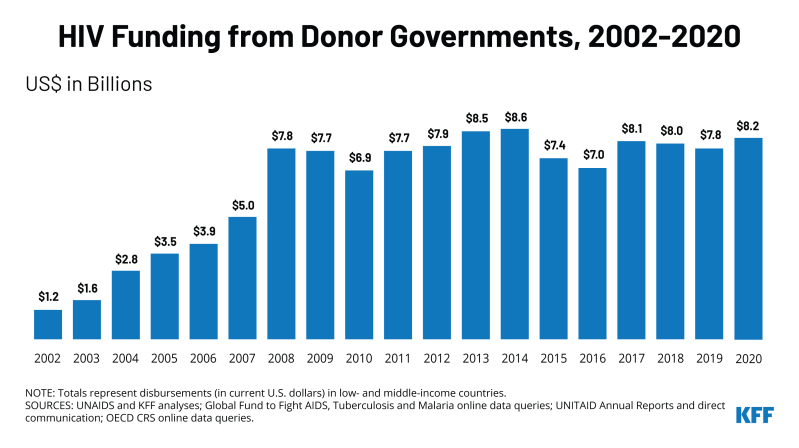
The independent source for health policy research, polling, and news.
KFF/UNAIDS Analysis Finds That While Donor Government Spending on HIV Increased in 2020, Future Funding is Uncertain with COVID-19 Challenges
The increase was largely due to disbursement of prior-year multilateral funds. Bilateral funding from donor governments, other than the U.S., continues a downward trend.
A new report from KFF (Kaiser Family Foundation) and The Joint United Nations Programme on HIV/AIDS (UNAIDS) finds that donor government disbursements to combat HIV in low- and middle-income countries increased by US$377 million in 2020, reaching US$8.2 billion in 2020 compared to US$7.8 billion in 2019. Donor government funding supports HIV care and treatment, prevention, and other services in low- and middle-income countries.
The rise in funding is almost entirely the result of an increase in United States contributions to the Global Fund to Fight AIDS, Tuberculosis and Malaria, which was due largely to the disbursement of prior-year funding. U.S. disbursements to the Global Fund are not expected to remain at this level in 2021.
The United States continues to be the largest donor to HIV, accounting for 76% of all donor government funding, followed by the United Kingdom (US$612 million, 7%), Japan (US$258 million, 3%), Germany (US$246 million, 3%), and France (US$216 million, 3%). As other donor governments continue to pull back bilateral funding, the United States accounts for an increasing share of overall funding for HIV from donor governments.
The report reflects prior-year political and funding decisions and does not fully capture the impact of COVID-19 on donor funding decisions.
“While many donor governments are beginning to bounce back from the pandemic, its global impact and related recession make future funding for HIV response unpredictable,” said KFF Senior Vice President Jen Kates. “Not only are some low- and middle-income countries experiencing a ‘third-wave’ of COVID-19, vaccines remain largely out of reach, potentially leading to greater funding needs for HIV and other health services.”
“We are at a critical stage in the AIDS response as countries are confronting the huge challenges posed by the COVID-19 pandemic,” said Winnie Byanyima, Executive Director of UNAIDS. “But we do still have an opportunity to end the epidemic by 2030 if donors and countries alike commit to mobilize resources and prioritize health, human rights and equality which are the key components, not only to lead us out of the pandemics of HIV and COVID-19, but they are the cornerstone to economic recovery and security.”
These data are included in a broader UNAIDS global report, which examines all sources of funding for HIV relief, including local governments, non-governmental organizations, and the private sector, and compares it to the resources needed to achieve goals related to testing and treatment.
The new report, produced as a long-standing partnership between KFF and UNAIDS for more than 15 years, provides the latest data available on donor government funding based on data provided by governments. It includes their bilateral assistance to low- and middle-income countries and contributions to the Global Fund, UNAIDS, and UNITAID. “Donor government funding” refers to disbursements, or payments, made by donors.
